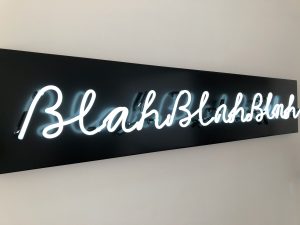 Ever had that feeling where you're telling a story, but no matter how many words or descriptions you use, something still feels lost in translation? It's like describing the taste of chocolate to someone who's never had a sweet in their life—it just doesn’t quite capture the full experience. In psychoanalysis, we often find ourselves in similar territory, where what’s left unsaid can be just as important as what is spoken. It’s in these unsaid spaces that the real work begins, where meaning hides beneath the surface, waiting to be discovered.
Ever had that feeling where you're telling a story, but no matter how many words or descriptions you use, something still feels lost in translation? It's like describing the taste of chocolate to someone who's never had a sweet in their life—it just doesn’t quite capture the full experience. In psychoanalysis, we often find ourselves in similar territory, where what’s left unsaid can be just as important as what is spoken. It’s in these unsaid spaces that the real work begins, where meaning hides beneath the surface, waiting to be discovered.
Gaps in language—like those moments when you suddenly forget a word mid-sentence or pause without knowing why—hold a certain mystery. For a psychoanalyst, these silences, hesitations, and slips are like clues in a puzzle, hinting that something important is lurking just beneath the surface. These moments offer a window into the unconscious, where underlying conflicts, desires, or anxieties are hidden. Just like Freudian slips, gaps in speech are not just absences of communication but can reveal deeper psychological truths. Psychoanalysts pay close attention to these lapses because they can point to areas of emotional or psychic conflict that the patient might not yet be able to articulate.
The silences or gaps might also reflect defences—ways the patient unconsciously avoids confronting certain thoughts or feelings. By exploring these interruptions in language, the analyst helps the patient bring repressed material into consciousness, facilitating insight and emotional processing.
In a psychoanalysis session, the focus is on understanding the unconscious mind—the part of our mind that holds hidden thoughts, feelings, and desires we’re not fully aware of. Here’s a simple breakdown of what happens:
Speaking freely: The patient is encouraged to talk openly about anything that comes to mind without censoring or filtering thoughts. This is called free association.
Exploring patterns: The analyst listens for patterns in what the patient says, looking for recurring themes or issues that may hint at deeper, unconscious conflicts.
Noticing slips and gaps: When the patient makes a slip of the tongue or pauses in their speech, the analyst pays attention. These moments may reveal hidden feelings or thoughts the patient is not fully aware of.
Processing: The goal is to uncover unconscious feelings, desires, or past experiences that influence the patient’s current behaviour or emotional struggles.
The meaning: Over time, the patient gains insight into how their unconscious mind affects their life, helping them go deeper into their psyches and make changes if desired.
The idea of gaps in language as connected to the unconscious ties into the notion that language cannot fully capture human experience or desire, leaving certain aspects unexpressed or even inexpressible. Both linguistics and psychoanalysis explore these gaps, but they do so from different angles. To understand this, we can further connect the work of Chomsky, Saussure, and Lacan to the concept of linguistic gaps and their relationship to the unconscious.
 Chomsky and Gaps in Language
Chomsky and Gaps in Language
Imagine someone fluent in English learning the Japanese concept of “wabi-sabi”—the appreciation of imperfection and transience in life. In English, there’s no exact word or phrase that fully captures the depth of wabi-sabi. This creates a gap in language, where a specific cultural idea cannot be easily expressed in another language. The person might describe it as “finding beauty in imperfections,” but even that feels incomplete.
From Chomsky’s perspective, while human brains are wired to learn language universally, each language develops to reflect its culture’s unique needs and concepts. When encountering ideas from other cultures that don’t fit neatly into the existing linguistic framework, speakers naturally try to fill the gap using descriptive phrases or metaphors until new vocabulary is established. Despite the gap, the person’s innate linguistic ability allows them to work around the missing word by constructing explanations that make sense within their language.
In Chomsky’s generative grammar, language is seen as a system governed by rules that allow for infinite creativity in sentence production. However, even within this system, there are limitations—certain ideas or emotions cannot be fully articulated by syntax and grammar alone. This suggests that while we are biologically endowed with the ability to produce complex linguistic structures, there remains a gap between thought (or internal experience) and language (its external expression). These gaps may be where the unconscious operates.
For example, there may be thoughts or emotions we struggle to put into words, not because of a lack of vocabulary but because language inherently lacks the capacity to fully express them. In Chomsky’s framework, this gap can be seen as a limit of our cognitive architecture. The cognitive unconscious supports the structure of language, but it does not guarantee that all thoughts or experiences can be translated into speech.
 Saussure and the Gaps Created by the Arbitrary Nature of Signs
Saussure and the Gaps Created by the Arbitrary Nature of Signs
Consider the word "snow." In English, it’s just one word for the white stuff that falls from the sky. But in some Inuit languages, there are over 50 different words for snow, each describing its unique texture or use. According to Saussure, this shows how the signifier (the sound or word) and the signified (the concept) vary dramatically between languages based on cultural needs. The Inuit people need many different words for snow because it’s a crucial part of their environment, while English-speaking cultures only need one or two. This illustrates Saussure's idea that language is not a direct reflection of reality but a system of signs agreed upon by a community.
Saussure’s theory of structural linguistics argues that language is a system of arbitrary signs. The relationship between the signifier (the word) and the signified (the concept) is arbitrary, meaning there is no inherent connection between the sound of a word and the thing it represents. This arbitrary nature of language introduces gaps between words and meaning.
The gap between the signifier and signified points to a lack of language’s ability to fully capture reality. We rely on signs to convey meaning, but these signs are social constructs, not perfect reflections of our internal states or the external world. The result is that language always falls short of complete expression, and these gaps in meaning can be linked to the workings of the unconscious. For example, Saussure would argue that the gaps in language reveal how our thought processes are constrained by the linguistic structures we are embedded in, with much of this happening below conscious awareness.
Lacan and the Unconscious as a Gap
Imagine you're in a meeting and your manager asks you for your opinion on a new project. You mean to say, “I think it’s a good idea,” but instead, you accidentally say, “I think it’s a bad idea.” Embarrassed, you correct yourself, but Lacan would argue that this “slip of the tongue” reveals your unconscious reservations about the project. It’s a small window into your deeper, possibly hidden feelings that language unintentionally lets out. In this sense, language acts as a bridge between the conscious and unconscious.
In Lacanian psychoanalysis, the gap in language becomes a central feature of the unconscious itself. For Jacques Lacan, language is not just a tool we use—it structures the unconscious. Lacan famously claimed that "the unconscious is structured like a language," suggesting that the way we repress, displace, and express desires follows the patterns of linguistic systems. However, there is a critical gap: language cannot fully express our unconscious desires.
Lacan introduces the concept of the "Real"—an aspect of experience that is beyond language and cannot be fully symbolised. This gap between language and the Real represents what remains unspeakable or unrepresented in our conscious experience. The unconscious manifests in these gaps: in slips of the tongue, repressed desires, or the way certain desires remain unformulated because language doesn’t provide the means to articulate them.
In Lacanian theory, desire itself is a gap (lack)—we are always desiring something beyond what language can express. The "lack" at the heart of human existence is tied to the structure of language. No matter how much we speak, there is always something missing, something ungraspable. This gap, Lacan argues, is where the unconscious operates, as our desires constantly shift around an absence that language cannot fill.
 The Gaps in Language and Unconscious Manifestation
The Gaps in Language and Unconscious Manifestation
Together, the ideas of Chomsky, Saussure, and Lacan suggest that the gaps in language—where meaning breaks down, where expression falters, and where representation fails—are key to understanding the unconscious. Here are a few ways these gaps manifest:
Inexpressibility of Experience: Language often fails to fully capture emotional or experiential nuance. This gap can be seen in moments where we struggle to find the words to describe a profound feeling or experience. Chomsky’s cognitive structures help us form sentences, but they cannot bridge the gap between internal experience and external expression.
Arbitrariness of Meaning: Saussure’s concept of the arbitrary sign introduces a fundamental gap in communication. The words we use are not tied to the essence of things but to social conventions. Thus, the unconscious often works through these gaps, revealing hidden thoughts in miscommunications, ambiguities, or unintentional slips.
Unrepresentable Desires: In Lacanian terms, the gap between language and the Real is the space where the unconscious hides and where repressed desires live. These are the desires that language cannot name directly, but that show up in other forms: dreams, slips, or symbols. The inability to fully express desire through language creates a persistent sense of lack, which drives unconscious thought.
Conclusion
The relationship between gaps in language and the unconscious weaves together the theories of Chomsky, Saussure, and Lacan. While Chomsky's cognitive unconscious structures how we produce language, it also reveals that not all thoughts can be linguistically represented. Saussure's structuralism points to the arbitrary nature of signs, introducing gaps in meaning, while Lacan views these gaps as the very essence of unconscious desire, which cannot be fully captured by language.
In the end, these gaps are not just limits of language—they are where the unconscious reveals itself, working through the spaces that words cannot fill.
Here are some key references that can support the ideas discussed in the blog about Chomsky, Saussure, and psychoanalysis, especially in relation to language and the unconscious:
- Noam Chomsky:
- Chomsky, N. (1957). Syntactic Structures. The Hague: Mouton.
- Chomsky, N. (1965). Aspects of the Theory of Syntax. Cambridge, MA: MIT Press.
- Ferdinand Saussure:
- Saussure, F. (1916). Course in General Linguistics (Edited by Charles Bally & Albert Sechehaye). Translated by Roy Harris, 1983. La Salle, IL: Open Court.
- Sigmund Freud:
- Freud, S. (1900). The Interpretation of Dreams. Standard Edition, Vol. IV-V. Translated by James Strachey.
- Freud, S. (1915). The Unconscious. Standard Edition, Vol. XIV.
- Jacques Lacan:
- Lacan, J. (2019). Desire and its Interpretation (Seminar VI) Translated by Bruse Fink. Polity
- Lacan, J. (1998). The Four Fundamental Concepts of Psychoanalysis (Seminar XI). Edited by Jacques-Alain Miller. Translated by Alan Sheridan. New York: Norton.
- Linguistic Theory and Psychoanalysis:
- Evans, D. (1996). An Introductory Dictionary of Lacanian Psychoanalysis. London: Routledge.
This text is a useful resource for exploring the connections between Lacanian psychoanalysis and linguistic structures, especially the idea of gaps and the unconscious.
- Contemporary Discussions:
- Benveniste, É. (1971). Problems in General Linguistics. Translated by Mary Elizabeth Meek. Coral Gables: University of Miami Press.
Benveniste offers critical insights into the relationship between linguistics and subjectivity, tying in well with discussions on the unconscious.
- Language and the Unconscious:
- Borch-Jacobsen, M. (1991). Lacan: The Absolute Master. Translated by Douglas Brick. Stanford: Stanford University Press.
This book elaborates on Lacan’s view of language and its limits in expressing the unconscious, further exploring how gaps in language serve as sites for unconscious desire.
